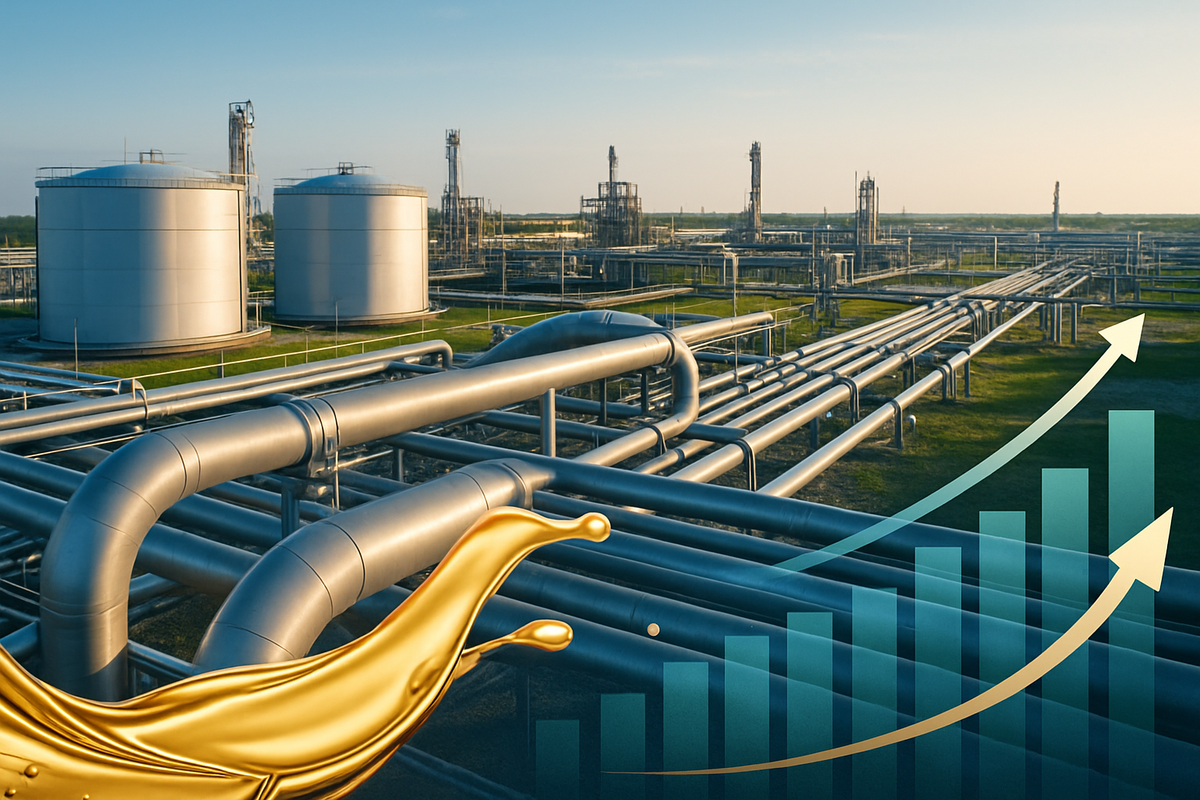
In an energy market often characterized by volatility, Enterprise Products Partners (NYSE: EPD) stands out as a beacon of stability and consistent income. This midstream energy behemoth, boasting an attractive dividend yield hovering around 7%, is not merely resting on its laurels but is actively forging a path of strategic growth. With a remarkable 27-year streak of increasing distributions, EPD has solidified its position as a "dividend aristocrat" in the energy sector, offering investors a compelling blend of current income and future potential.
The company's robust financial health and its extensive network of critical energy infrastructure underscore its importance in the North American energy landscape. As of October 2025, EPD continues to execute on a multi-billion-dollar organic growth program, signaling a clear commitment to expanding its operational footprint and enhancing its capacity to serve growing energy demands. This proactive stance, coupled with its largely fee-based business model, insulates the company from the direct whims of commodity price fluctuations, making it a potentially resilient investment in a dynamic market.
Sustained Performance and Ambitious Expansion Fueling Investor Confidence
Enterprise Products Partners has consistently demonstrated strong operational and financial performance, underpinning its attractive dividend and growth narrative. The company concluded 2024 with record adjusted EBITDA of $9.9 billion and distributable cash flow (DCF) of $7.8 billion, marking a 3% increase over 2023. This robust performance allowed EPD to retain $3.2 billion of DCF, reinforcing its balance sheet and funding future projects. The dividend coverage ratio, a critical metric for unitholder security, has consistently remained strong, with 1.7x for both full-year 2024 and the first half of 2025, well above the 1.2x desired by rating agencies.
The momentum continued into 2025, with Q1 2025 revenues increasing to $15.42 billion year-over-year, and although net income saw a slight dip, the company's underlying operational strength remained evident. Q2 2025 saw EPS exceed analyst estimates, with distributable cash flow growing by 7% to $1.8 billion, covering its distribution by a comfortable 1.6 times. Looking ahead, EPD is scheduled to announce its Q3 2025 earnings on October 30, 2025, having already declared a quarterly cash distribution of $0.545 per unit for the quarter, a 3.8% increase from the prior year. This consistent growth in distributions, averaging 4.94% over the past three years, highlights the company's commitment to returning value to its unitholders.
Central to EPD's growth narrative is its ambitious capital investment program. The company anticipates completing approximately $6 billion in organic growth capital projects by the end of 2025, with total projects in progress amounting to $7.6 billion through the end of 2026. Key projects slated for completion in 2025 include two new gas processing plants in the Permian Basin, the first phase of its new Neches River Terminal for NGL exports, another NGL fractionator (Frac 14 at Mont Belvieu), and the Bahia NGL pipeline. Furthermore, an acquisition of a natural gas gathering affiliate from Occidental Petroleum (NYSE: OXY) for $580 million added approximately 200 miles of pipelines in the Midland Basin. For 2026, EPD plans to invest another $2.2 billion to $2.5 billion, with projects like the Mentone West 2 gas processing plant and the second phase of the Neches River Terminal expected to come online, largely supported by long-term contracts designed to drive increased revenue and cash flow well into 2027.
Ripple Effects Across the Energy Value Chain
Enterprise Products Partners' enduring strength and growth trajectory have significant implications for various stakeholders across the energy sector. For EPD unitholders, the consistent dividend growth and robust financial performance translate into a reliable income stream and potential capital appreciation, making it an attractive option for income-focused investors. The company's "financial fortress" status, backed by A- credit ratings from S&P, Fitch, and Moody's, provides a strong foundation for continued stability.
Other midstream companies may find themselves in a competitive landscape, needing to innovate and expand their own infrastructure to keep pace with EPD's aggressive growth. Companies like Kinder Morgan (NYSE: KMI), Energy Transfer (NYSE: ET), and Magellan Midstream Partners (NYSE: MMP) (now part of Oneok (NYSE: OKE)) operate in similar spaces, and EPD's strategic expansions could either create new partnership opportunities for shared infrastructure or intensify competition for new projects and customer contracts. Its dominance in the NGL market, with integrated infrastructure from transportation to processing, gives it a distinct competitive edge.
Upstream producers benefit from EPD's expanded capacity to transport, process, and store crude oil, natural gas, and NGLs, particularly in prolific regions like the Permian Basin. This provides reliable takeaway capacity, crucial for monetizing their production. Conversely, downstream petrochemical and refining companies rely on EPD's network to supply feedstocks and transport refined products, ensuring supply chain efficiency. The expansion of NGL export terminals, for instance, directly benefits producers by opening up international markets for their products, and petrochemical players by providing access to global feedstock supplies. EPD's ability to maintain high utilization rates and secure long-term contracts with these players solidifies its indispensable role in the energy value chain.
Broader Industry Trends and Strategic Positioning
EPD's success is deeply intertwined with and reflective of broader trends in the North American energy midstream sector. The industry has increasingly shifted towards a fee-based business model, largely de-risking operations from the direct impact of volatile commodity prices. EPD exemplifies this trend, with approximately 90% of its contracts featuring escalation provisions to mitigate inflation, providing predictable and stable cash flows. This model is particularly attractive to investors seeking defensive plays within the energy sector.
The company's strategic focus on natural gas liquids (NGLs) is another key industry trend. North America's abundant shale gas production has led to a surplus of NGLs, driving demand for infrastructure to process, transport, and export these valuable hydrocarbons. EPD's extensive NGL pipeline network, fractionators, and export terminals position it as a dominant player in this critical segment. Its integrated NGL value chain allows it to capitalize on market movements and secure long-term contracts, further diversifying its revenue streams. The emphasis on export capabilities, particularly for ethane and ethylene, aligns with the growing global demand for these petrochemical feedstocks, reinforcing the U.S.'s role as a major energy exporter.
Regulatory and environmental considerations continue to shape the midstream landscape. While EPD's existing infrastructure largely benefits from established permits, new projects face increasing scrutiny. However, the critical nature of its infrastructure for energy security and economic activity often provides a degree of regulatory stability. Historically, master limited partnerships (MLPs) like EPD have been favored for their tax advantages and high distributions, though investor sentiment can shift with changes in tax policy or market perception. EPD's strong credit ratings and disciplined capital management are crucial in navigating these dynamics, allowing it to pursue opportunistic acquisitions and growth projects while maintaining financial flexibility.
The Road Ahead: Opportunities and Challenges
Looking forward, Enterprise Products Partners is poised for continued expansion and adaptation within the evolving energy landscape. In the short term, the completion of its substantial organic growth projects through 2025 and 2026 will be paramount. As new gas processing plants, NGL terminals, and pipelines come online, they are expected to significantly boost the company's operational capacity and revenue-generating potential. The successful integration of these assets and the securing of additional long-term contracts will be key indicators of immediate growth.
In the long term, EPD's strategic pivots will likely involve further optimization of its existing assets and potential expansion into new energy vectors, such as carbon capture, utilization, and storage (CCUS), or hydrogen, though its core focus remains on traditional hydrocarbons. The company's robust balance sheet and strong liquidity position of $5.1 billion provide ample flexibility for opportunistic acquisitions, allowing it to consolidate its market share or enter new strategic areas. Market opportunities may emerge from sustained demand for U.S. energy exports, particularly NGLs, and the ongoing need for reliable infrastructure to connect producing basins to demand centers.
However, challenges remain. Fluctuations in commodity prices, while mitigated by EPD's fee-based model, can still impact producer activity and, consequently, volumes flowing through its systems. Rising interest rates could increase borrowing costs for future capital projects, although EPD's strong credit ratings and disciplined financial management should help mitigate this risk. Regulatory hurdles and environmental activism could also pose challenges for new pipeline development. Nevertheless, EPD's diversified portfolio, critical infrastructure, and strong financial health suggest a resilient future, with management focusing on operational efficiency and strategic investments to drive sustained growth and unitholder returns.
A Cornerstone Investment in the Evolving Energy Sector
Enterprise Products Partners (NYSE: EPD) continues to affirm its status as a cornerstone investment within the North American energy midstream sector. The company's current robust dividend yield, consistently around 7%, coupled with an impressive track record of 27 consecutive years of distribution increases, underscores its commitment to unitholder returns and its financial stability. The ongoing multi-billion-dollar organic growth program, targeting significant expansions in gas processing, NGL fractionation, and export capabilities through 2026, provides a clear roadmap for future cash flow generation and reinforces its strategic importance in the energy value chain.
The key takeaways from EPD's current standing are its financial resilience, evidenced by strong credit ratings and conservative leverage, and its strategic positioning in high-growth areas like NGLs and exports. Its largely fee-based business model offers a significant buffer against commodity price volatility, providing a more predictable earnings stream compared to upstream or downstream counterparts. As the energy market continues to evolve, EPD's extensive and integrated infrastructure network remains critical for the efficient transportation and processing of vital energy resources.
Moving forward, investors should closely monitor the successful completion and commissioning of EPD's numerous growth projects, as these will be primary drivers of future cash flow and distribution growth. The company's ability to secure additional long-term contracts for its expanded capacity will also be crucial. While macroeconomic factors, such as interest rate movements and global energy demand, will always play a role, EPD's disciplined management and strategic investments position it well to navigate these dynamics. For those seeking a blend of high, reliable income and exposure to essential energy infrastructure, Enterprise Products Partners presents a compelling case for consideration in the coming months and years.
This content is intended for informational purposes only and is not financial advice







